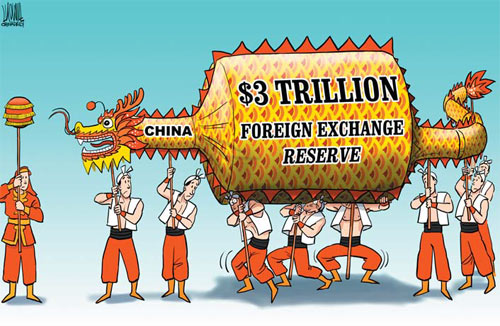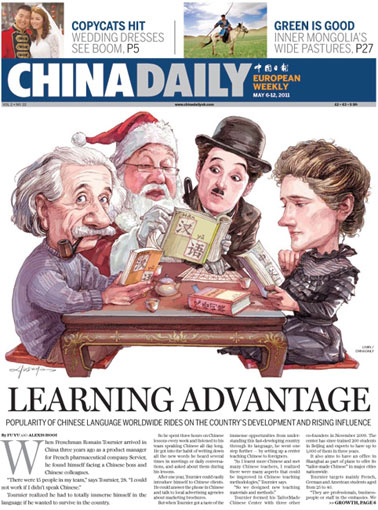US debt in China's forex reserves worrisome
Updated: 2011-05-06 10:32
By Zhang Ming (China Daily European Weekly)
 |
China's foreign currency reserves topped $3 trillion (2 trillion euros), according to the latest data from the People's Bank of China (PBOC).
The foreign currency reserves in China, already the largest in the world, grew by nearly $200 billion in the first quarter of this year.
PBOC continues to accumulate foreign currency reserves. If this continues, China's foreign reserves will reach new highs.
Between 2006 and 2010, China's reserves grew by nearly $2 trillion, with an average annual increase of about $400 billion. In the first quarter of 2011, China's foreign currency reserves increased by $197 billion.
According to the International Monetary Fund, at the end of 2010, 61 percent of the country's foreign reserves were put into US dollar-backed assets, 26 percent in yen-backed assets and 13 percent in other currency assets.
An annual report released in February by the United States Treasury Department said at the end of June 2010, China had purchased $1.1 trillion in US government debt, $360 billion in institutional debt, $126.5 billion in US stocks and $11.9 billion in company debt.
The volume, $1.6 trillion, accounts for 66 percent of China's foreign currency reserves at the end of June 2010, up from the IMF's estimate of 61 percent.
The report reflects the composition of China's foreign currency reserves. Bonds make up 90 percent of the assets, while nearly 70 percent of the bonds are used to invest in US government debt.
The latest US Treasury report said that, at the end of February, China's investors had purchased $1.1 trillion in US government debt. Even though China has not released the make-up of its reserves, we estimate a range of $1.3 trillion to $1.5 trillion has been invested in US government debt. This figure accounts for 43 percent to 49 percent of China's current foreign currency reserves.
The US Treasury market is the center of the global financial system. It is the deepest and most liquid bond market in the world, and demand from central banks and institutional investors, including private sector banks and hedge funds, has allowed the American government to finance its multibillion-dollar budget deficit.
For the first time, credit rating agency Standard & Poor's cut its outlook of the US debt from "stable" to "negative" last month. A negative outlook means there is 33 percent chance it will be downgraded again in the next two years.
Since S&P introduced its outlook system in 1991, it has never given the US a negative outlook. The downgrade could be a result of the damage to US credit after the subprime mortgage crisis, the decade of tax cuts or the spending increases followed by a massive stimulus program during the recession.
The US government has injected $2.8 trillion into the economy since 2008. Serious defects in the US economic development and management model has led to the long-term recession of its national economy, fundamentally lowering the national solvency.
The second quantitative easing measure has contributed to the depreciation of the dollar, and the continuation and deepening of the credit crisis in the US.
The actions of the US seem as though it is using a helicopter to drop money from the sky. Such a move entirely encroaches on the interests of the creditors, indicating the decline of the US government's intentions to repay its debt.
Analysis shows that the crisis confronting the US cannot be ultimately resolved through currency depreciation. On the contrary, it is likely that an overall crisis might be triggered by the US government's policy to continuously depreciate the dollar against the will of its creditors.
A pillar of the global financial system tottered when S&P cut its outlook on US sovereign debt. Some believe the US government will repay the money, however, other creditors are worried that the US government will reduce its debt burden by decreasing the value of the dollar, thus creating inflation.
In March, investment firm Pimco cut its holdings of US government-related paper to zero for the first time in the history of the firm.
Its move to cut exposure to government debt fits the public comments made by Bill Gross, the manager of the $237 billion fund. He is an outspoken critic of both the US deficit and stimulus measures taken by the Federal Reserve.
So how should the PBOC, the largest creditor of US government debt, deal with the current situation?
As long as China's foreign currency reserves continue to grow, the PBOC has to purchase the US government debt in order to keep the value of the current assets. China is facing the challenge of how to diversify its foreign reserves, and more seriously, the country is facing the challenge of how to resist the rise of China's foreign reserves.
First, China should gradually move to a slightly more flexible exchange rate plan that will reduce the trade surplus. Second, China should remove the incentive policies to foreign investors, which will decrease the foreign direct investment. Third, the Chinese government should strengthen the regulations on capital and financial accounts, preventing more foreign short-term capital from increasing the foreign reserves.
The author is a scholar with the Institute of World Economics & Politics under the Chinese Academy of Social Sciences.
E-paper

Head on
Chinese household care goods producers eye big cities, once stronghold of multinational players
Carving out a spot
Back onto center stage
The Chinese recipe
Specials

Bin Laden dead
The world's most wanted man was killed in a US raid in Pakistan.

British Royal Wedding
Full coverage of the royal wedding of Prince William and Kate Middleton in London. Best wishes

The final frontier
Xinjiang is a mysterious land of extremes that never falls to fascinate.
